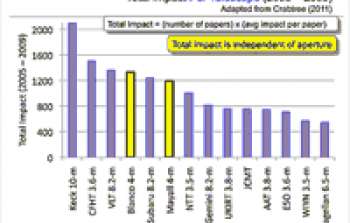sci12003 — Announcement
Strong Science in the Face of Budget Challenges
April 30, 2012
by NOAO Director David Silva
A Vibrant Scientific Landscape
It’s an exciting time at NOAO.
Publication statistics demonstrate the high scientific impact of the Blanco and Mayall telescopes. Following Crabtree, the impact of a paper is defined as “the ratio of the number of citations that paper has received to the citation count for the average AJ paper of the same year.” The relative productivity of the Mayall and Blanco would be further enhanced if their impact were considered on a per-dollar-invested basis.
The 4-m class facilities we wholly operate (Blanco and Mayall) continue to produce many high impact papers per year. Indeed, the Blanco and Mayall 4-m telescopes are among the most productive ground-based astronomical facilities in the world, at any wavelength or aperture size, even more so when considered on a per-dollar-invested basis. They are also critical enabling nodes in the overall US Optical-Infrared (OIR) System. Over 1400 investigators from more than 300 institutions are supported annually by NOAO on telescopes from 1-m to 10-m in aperture size throughout the US OIR System.
But we are not resting on current success. NOAO is currently deploying a new generation of imagers and spectrometers on all four 4-m class telescopes we wholly or partially operate. Enabled by State and Federal funding, these new instruments have been developed in partnership with groups at universities as well as national physics labs. Even as I write, the DOE-funded Dark Energy Camera, developed at Fermilab, is being installed at the Blanco. And we have high hopes for deploying in 2017 the DOE-funded BigBOSS spectrometer, which is being developed for the Mayall through a collaboration led by Lawrence Berkeley National Lab. As a result of significant financial, intellectual, and technical investment over the last 10+ years, NOAO has been one of the major forces driving LSST to the forefront of the Federal ground-based astronomy investment strategy for the next 20 years.
In short, NOAO has tunneled through to a new era, one built on incredibly strong collaborations with the physics cosmic frontier community without losing contact with our traditional stakeholders in the astronomy community. We are not the NOAO of 20 years ago – we are something new, equally exciting and likely to produce even higher scientific impact to 2025 and beyond.
Budget Challenges
At the same time, NOAO faces significant challenges. Our parent-funding agency, the National Science Foundation, is struggling to maintain investment in our program. After adjustment, our FY 12 base funding was roughly $2.7M less than planned, down from $29.2M to $26.5M. For FY 13, NOAO base funding is projected to be no more than $25.5M, another $1M reduction. As a result of these funding reductions, it was necessary to reduce both NOAO labor and non-labor expenditures. Our total work force has been reduced by 10% compared to the beginning of the 2012 fiscal year. Personnel reductions occurred in all skill areas – administrative, technical, and scientific.
Instrumentation development is the NOAO activity most affected by these actions. Although new, more efficient general-purpose instruments are being deployed on all four 4-m class telescopes over the next 6-12 months, those projects are ramping down. In order to preserve other activities, NOAO made the painful decision to reduce our capacity to build and deploy instrumentation independent of other partners. Fortunately, NOAO has retained a talented technical workforce that is deeply involved in LSST, DES/DECam, and BigBOSS as well as regular 4-m telescope operations and maintenance activities. That expertise could be redeployed to instrumentation projects in the future as funding permits.
High Science Impact into the Future
By design, the resultant NOAO program continues to enable high science impact over the next three to five years while supporting previously established high priority future-looking projects.
Specific preserved activities include:
- Operations and maintenance of four 4-m class telescopes (Blanco, Mayall, SOAR, WIYN) (including Blanco f/8 secondary repair and return-to-service work)
- Gemini user support through the US National Gemini Office (NGO)
- LSST telescope and site design development support
- DES/DECam commissioning and operations support
- BigBOSS development, including planning for necessary Mayall preparation and modification
- Completion of the ReSTAR-1 instrumentation program (KOSMOS/COSMOS, TripleSpec, Blanco Hydra upgrade)
- Completion of the SOAR GLAO imager (SAM/SAMMI)
- Deployment of the WIYN One Degree Imager with a partially filled focal plane
- Various mission-critical data management activities (including IRAF support and pipeline development support for DECam and pODI).
Looking further into the future, NOAO remains eager to engage with Giant Magellan Telescope and/or Thirty Meter Telescope within a larger strategic framework of Federal investment in those next generation systems.
In the face of significant financial challenges, NOAO remains a strong, vibrant organization with a very bright future involving a significantly enlarged user community working at the science frontiers. We are proud of our past, but we are looking towards an excellent future and the world-leading research our user community will produce using the capabilities NOAO will deploy on their behalf.
Community Engagement
We rely on community input to ensure that our planning activities are consistent with community expectations and needs. Please send your thoughts on this article to currents@noao.edu.
Contacts
currents@noao.edu
About the Announcement
| Id: |
ID
sci12003
|
